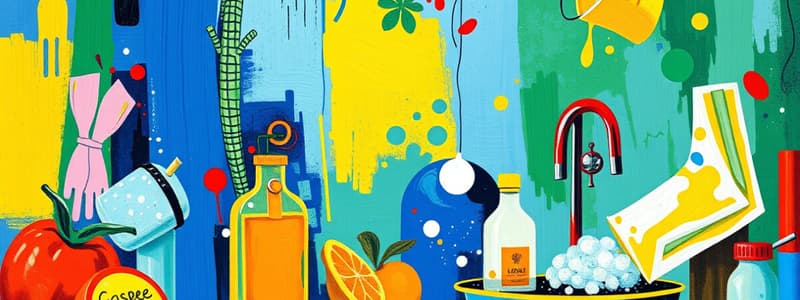Podcast
Questions and Answers
Generally, operations that use a private water source, such as a well, must have it tested at least how many years?
Generally, operations that use a private water source, such as a well, must have it tested at least how many years?
Once a year
Backflow is when water does what?
Backflow is when water does what?
Flows opposite its normal direction because of water pressure
What is a cross-connection?
What is a cross-connection?
Link between sources of safe and dirty water
A hose attached to a utility-sink faucet and left sitting in a bucket of dirty water could contaminate the water supply.
A hose attached to a utility-sink faucet and left sitting in a bucket of dirty water could contaminate the water supply.
Signup and view all the answers
How hot should the hot water at a handwashing station get?
How hot should the hot water at a handwashing station get?
Signup and view all the answers
When installing tabletop equipment on legs, the space between the base of the equipment and the tabletop must be at least?
When installing tabletop equipment on legs, the space between the base of the equipment and the tabletop must be at least?
Signup and view all the answers
There must be a minimum of twenty foot-candles of light (215 lux) in a food-preparation area.
There must be a minimum of twenty foot-candles of light (215 lux) in a food-preparation area.
Signup and view all the answers
Grease on an establishment's ceiling can be a sign of inadequate ventilation.
Grease on an establishment's ceiling can be a sign of inadequate ventilation.
Signup and view all the answers
What is the only completely reliable method for preventing backflow?
What is the only completely reliable method for preventing backflow?
Signup and view all the answers
Handwashing stations are required in dishwashing and service areas.
Handwashing stations are required in dishwashing and service areas.
Signup and view all the answers
To keep food from being contaminated by lighting, use what?
To keep food from being contaminated by lighting, use what?
Signup and view all the answers
Foodservice equipment that has been certified as meeting certain standards may be stamped with the ___ mark.
Foodservice equipment that has been certified as meeting certain standards may be stamped with the ___ mark.
Signup and view all the answers
When mounted on legs, tabletop equipment must be at least two inches (five centimeters) off the floor.
When mounted on legs, tabletop equipment must be at least two inches (five centimeters) off the floor.
Signup and view all the answers
What information should be posted on or near a dishwasher?
What information should be posted on or near a dishwasher?
Signup and view all the answers
Which is a source of potable water?
Which is a source of potable water?
Signup and view all the answers
Outdoor garbage containers should be what?
Outdoor garbage containers should be what?
Signup and view all the answers
Study Notes
Food Safety Management System
-
Private water sources, like wells, require annual testing for safety.
-
Backflow occurs when water flows in the opposite direction due to pressure changes.
Cross-Connections and Contamination
-
A cross-connection is the link between safe drinking water and contaminated sources.
-
A hose left in dirty water (e.g., utility-sink faucet) can contaminate the water supply, confirming the importance of proper connections.
Handwashing and Water Temperature
-
Hot water at handwashing stations must be at least 100°F (38°C) to ensure effective sanitation.
-
Handwashing stations are essential in dishwashing and service areas to maintain hygiene standards.
Equipment Installation and Lighting
-
Tabletop equipment must have a clearance of at least 4 inches (10 centimeters) from the tabletop.
-
Food-preparation areas need a maximum of 50 foot-candles (540 lux) of light for optimal visibility; a minimum of 20 foot-candles (215 lux) is required in various other areas like handwashing stations and buffets.
Ventilation and Backflow Prevention
-
Grease accumulation on ceilings indicates poor ventilation, posing health risks.
-
The most effective method to prevent backflow is creating an air gap between water sources.
NSF Certification and Dishwasher Information
-
Equipment meeting safety standards will display the NSF mark for assurance of compliance.
-
Key information to post near dishwashers includes water temperature, conveyor speed, and water pressure.
Potable Water Sources and Waste Management
-
Potable water can come from sources like water transport vehicles.
-
Outdoor garbage containers should always be covered with tight-fitting lids to prevent contamination and pest attraction.
Studying That Suits You
Use AI to generate personalized quizzes and flashcards to suit your learning preferences.
Description
Test your knowledge on food safety management systems, including water safety, cross-connections, and handwashing practices. This quiz covers essential standards and best practices to ensure hygiene in food preparation areas. Explore critical aspects such as equipment installation and proper lighting requirements for optimal food safety.




